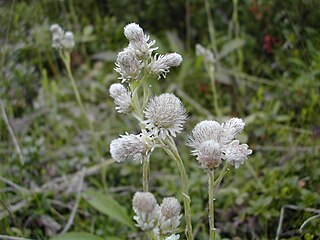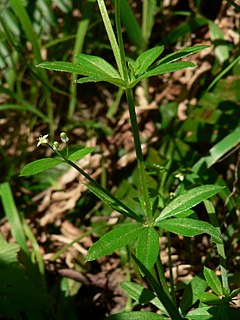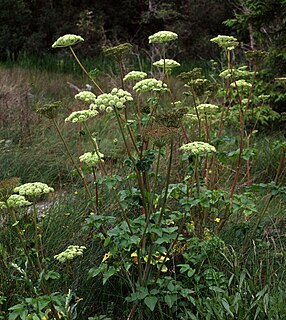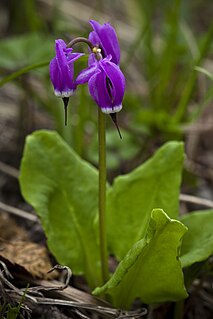
Antennaria alpina is a European and North American species of plant in the family Asteraceae. Antennaria alpina is native to mountainous and subarctic regions of Scandinavia, Greenland, Alaska, and the Canadian Arctic, extending south at high altitudes in mountains in the Rocky Mountains south to Montana and Wyoming.

Allium validum is a species of flowering plant commonly called swamp onion, wild onion, Pacific onion, or Pacific mountain onion. It is native to the Cascade Range, to the Sierra Nevada, the Rocky Mountains, and other high-elevation regions in California, Oregon, Washington, Nevada, Idaho and British Columbia. It is a perennial herb and grows in swampy meadows at medium and high elevations.

Galium triflorum is a herbaceous plant of the family Rubiaceae. It is widespread in northern Europe, eastern Asia and North America. The plant is considered a noxious weed in New York, Pennsylvania, Vermont, New Hampshire, Connecticut and Massachusetts.

Salix lucida, the shining willow, Pacific willow, red willow, or whiplash willow, is a species of willow native to northern and western North America, occurring in wetland habitats. It is the largest willow found in British Columbia.

Angelica lucida is a species of angelica known by the common names seacoast angelica and sea-watch. It is also one of many species in the celery family which are casually called wild celery.

Alf Erling Porsild (1901–1977) was a Danish-Canadian botanist.

Clintonia uniflora, commonly known as bride's bonnet, queen's cup, or bead lily, is a species of flowering plant in the lily family Liliaceae. The specific epithet uniflora means "one-flowered", a characteristic that distinguishes this species from others in the genus Clintonia. For this reason, it is also known as the single-flowered clintonia.

Erigeron peregrinus is a North American species of flowering plants in the family Asteraceae known by the common name wandering fleabane.

Agoseris aurantiaca is a species of plant in the family Asteraceae, commonly called orange agoseris or mountain dandelion. It is widespread in western North America.

Carex rossii, commonly known as Ross's sedge, is a hardy species of sedge that is often a pioneer species in areas with little or no established vegetation, or in places where disturbance has occurred. Ross's sedge grows in a variety of habitats throughout much of western North America, from Alaska to Ontario, south to New Mexico and California. It flowers in May and June.
Erigeron muirii, or Muir's fleabane, is a rare Arctic species of flowering plant in the family Asteraceae. It has been found only in northern Alaska and the northern Yukon Territory, including Herschel Island in the Arctic Ocean. It grows in tundra, dry slopes, and rock outcrops.

Galium trifidum is a species of flowering plant in the coffee family, known by the common name three-petal bedstraw. It grows widespread in the arctic, temperate and subtropical regions of the Northern Hemisphere: northern and central Asia, northern and eastern Europe and much of North America.
Silene taimyrensis, or Taimyr catchfly, is a herbaceous perennial in the family Caryophyllaceae. It is native to the Yukon and British Columbia in Canada and to Alaska. It is found to an elevation of a 1500 meters, growing in exposed subalpine to alpine locations with poor, rocky to sandy soils. It grows to a height of 40 cm in its native habitat and to twice that height as a garden plant; it has small, white to light pink flowers that grow in terminal clusters. S. taimyrensis is known in the fossil record from the Late Pleistocene.

Salix brachycarpa is a species of flowering plant in the willow family known by the common names barren-ground willow, small-fruit willow and shortfruit willow.

Primula frigida, synonym Dodecatheon frigidum, commonly called the western arctic shootingstar, is a plant species found in arctic and subarctic regions in the northwestern part of North America and in Asiatic Russia.
Minuartia yukonensis, the Yukon sandwort or Yukon stitchwort, is a plant species native to Yukon and Northwest Territories of Canada, as well as Alaska, and The Russian Far East. Flora of North America and some other publications also report it from British Columbia, but more recent work shows those collections to have been misidentified. Minuartia yukonensis grows in dry, rocky meadows at elevations less than 1000 m.
Kobresia sibirica, the Siberian bog sedge, is a plant species known from arctic and alpine tundra in Siberia, the Russian Far East, Alaska, Yukon, the Canadian Northwest Territories, Nunavut, British Columbia, Colorado, Utah, Montana, and Wyoming. Some authorities have considered the North American collections as distinct species, but they are more often tentatively regarded as conspecific with K. siberica, but this is pending further investigation.

Galium kamtschaticum, known as Kamchatka bedstraw or boreal bedstraw, is a plant species in the Rubiaceae, named for the Kamchatka Peninsula on the Pacific Coast of Russia. The species is native to northeastern Asia and northern North America: Russia, northeastern China, Korea, Japan, Alaska, Canada, and the northern part of the contiguous United States.
Antennaria friesiana, or Fries' pussytoes, is an Arctic species of plants in the family Asteraceae. It is the northern reaches of Asia and North America. Many of the populations lack male (staminate) flowers and reproduce asexually.

Antennaria monocephala, the pygmy pussytoes, is a flowering plant in the family Asteraceae. It is native to arctic and alpine regions of North America as well as the Chukotka (Chukchi) Peninsula of Russia.















